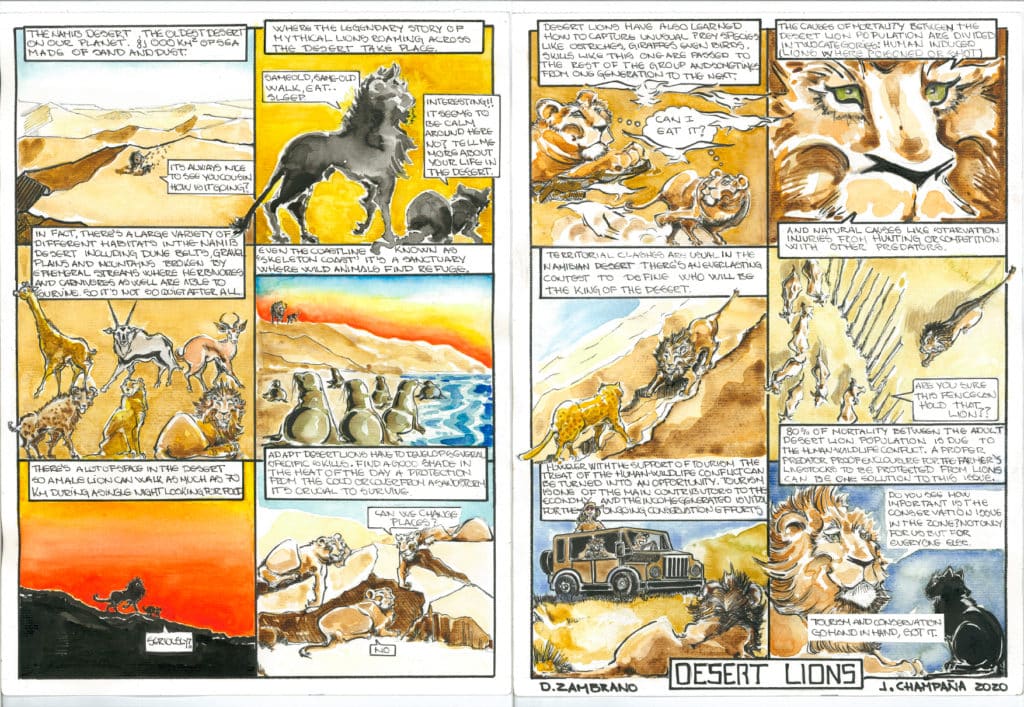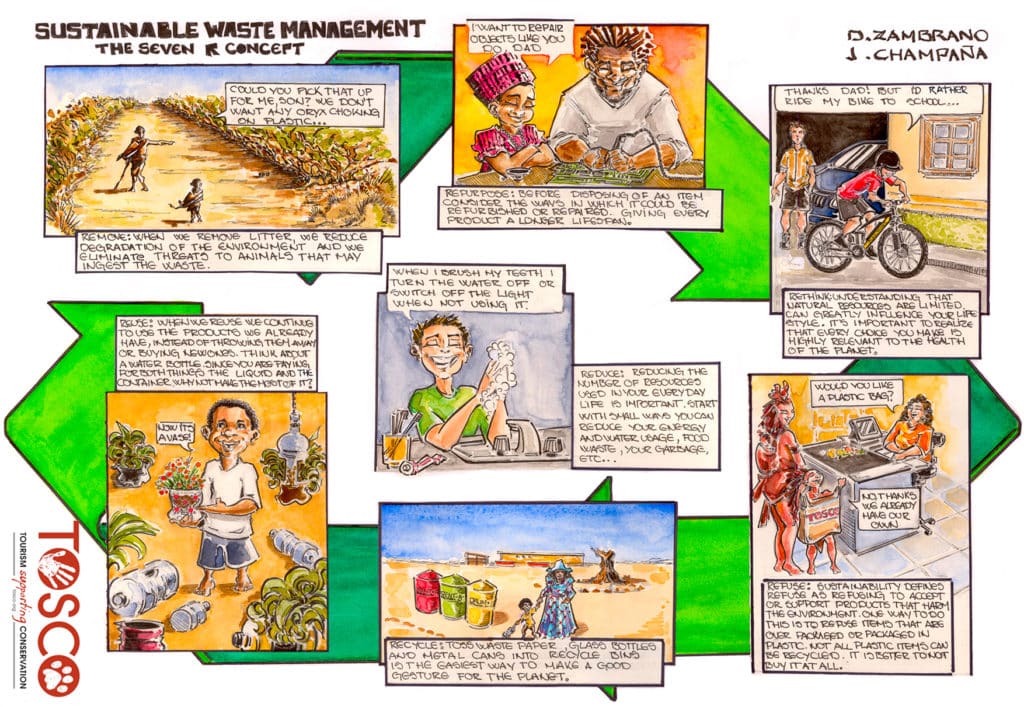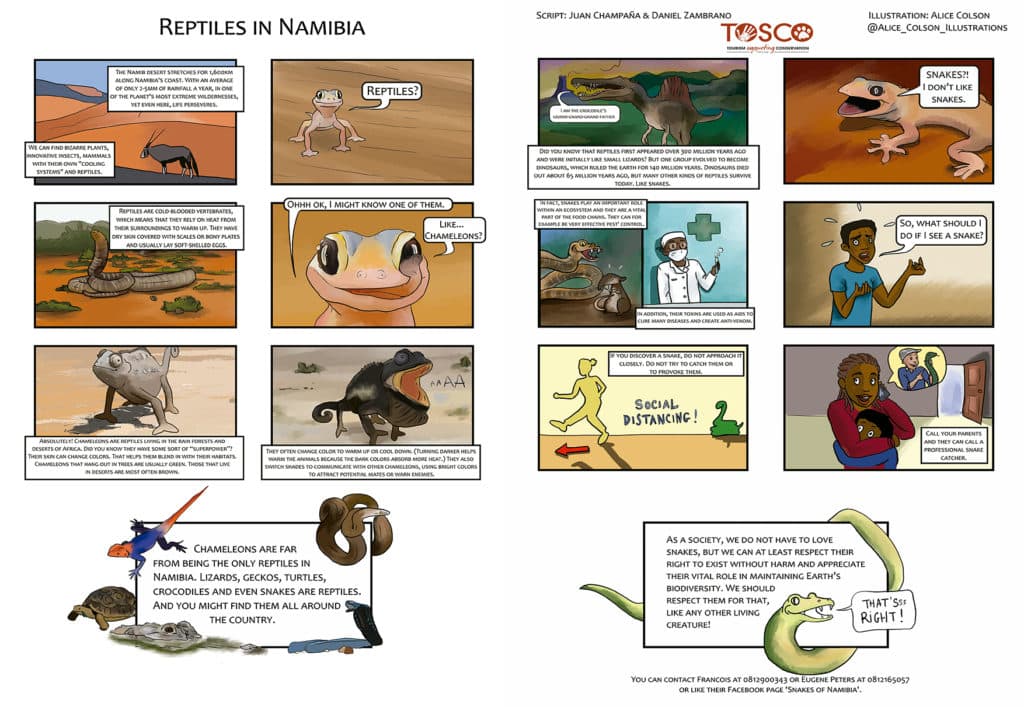How do you explain the importance of reptiles in a country where snakes are often feared? Or safeguarding lions that live in the oldest desert in the world? How do we raise awareness about the issues impacting the environment upon which we all depend – especially to kids, who represent the future of biodiversity conservation?
These are some questions that two Namibian organizations and some international artists have been asking themselves.
They imagined a project to raise environmental awareness through comics, combining beautiful designs and storytelling, inspired by scientific studies or collaboration. The project addresses subjects like human-wildlife conflict, water resources, or even poaching – subjects that might be difficult for teachers and parents to explain to children.

In this comic, a cat talks to a desert lion about life in the Namib Desert and how tourism supports conservation of this unique population.
How did this project get started?
In southern Africa, between Angola and South Africa, we find Namibia. It’s a big country – almost 2 times the size of France but with 2.5 million inhabitants!
Namibia is a semi-arid country which holds the oldest desert in the world: the Namib Desert. It’s one of the few countries where we can still find megafauna like lions, elephants, leopards, and more freely roaming outside national parks. However, this freedom comes with a huge challenge: coexistence often results in human-wildlife conflict.
Kids sometimes have the perception that nature and animals are just there – they have always been there and are always going to be there. That’s why we found it important to create an environmental education project for children in Namibia. We want to inform them about their country’s wondrous resources and invite them to participate in the protection of nature. Education connects us to the world around us, helping us raise awareness about issues impacting the environment upon which we all depend. Therefore, it is very important to bring nature into the classroom, take students outside to learn, or find impromptu teachable moments on a nature walk with our families. If we change the mindset of children, they can help us change the mindset of their parents!

This comic introduces readers to the seven “R’s” of sustainable waste management: Remove, Repurpose, Rethink, Refuse, Reduce, Recycle, and Reuse
Where did we get all of this information?
This project was developed in Windhoek, Namibia, by TOSCO (Tourism Supporting Conservation) and PAKO Kids Magazine.
TOSCO generates funds from the tourism sector to support rural populations in their efforts to safeguard wildlife. TOSCO also strives to provide a communication platform for stakeholders and increase awareness on conservation issues and responsible tourism in Namibia.
Pako Kids Magazine combines information, games, posters, experiments, and more to wake children’s interest in nature while having fun. PAKO Kids Magazine offers parents and teachers an easy way to extend their child’s learning beyond the classroom.
Two international artists responded to their call:
Alice Colson is a French illustrator working with both traditional methods like watercolours and modern ones like digital painting. Her background as an independent consultant on issues of climate change and sustainable development allows her to create educational illustrations that raise awareness while still being fun.
J. Champania is a Venezuelan self-taught creator based in Paris. Constantly evolving and learning, with a strong interest in traditional techniques such as Chinese ink and watercolors, J. Champania focuses his artistic potential on creating comic strips, graphic novels, illustrations, and everything related to the 9th Art.

This comic describes the diversity and importance of reptiles in Namibia, including some safety precautions that readers can use to coexist with more dangerous species, like snakes.
A multitude of scientific organizations support the project to illustrate what is happening in Namibia’s environment.
“Reptiles in Namibia” was validated by Francois Theart, a renowned snake expert who manages the Namibian Snakes Association. Mr. Theart is actively involved in a research program aiming to gather data on human-wildlife conflict in collaboration with the Namibia University of Science and Technology and the Ministry of Environment, Forestry and Tourism.
The information from “The Marine Mammals” was extracted from articles published by the Namibian Dolphin Project.
The comic about the Desert Lions was based on “Vanishing Kings” by Dr. Philip Stander, who is the director of Desert Lion Conservation. He has been carrying out an ongoing study on Namibia’s desert lions for the past 20 years.
“Water, a precious resource” was based on the artist’s experience as an independent consultant dealing with subjects related to climate change and sustainable development.
What’s next?
Despite the coronavirus crisis, the collaboration created six mini comics in 2020, with 5,000 copies printed for each edition. These magazines were distributed in 40 schools all around Namibia. The project will continue in 2021 with six new editions for the Namibian audience. We plan to continue developing the program in other southern African countries and creating synergies with other organizations to reach more kids.
Now, we’re calling all comic designers with a passion to tell stories related to environmental and wildlife protection. We have other projects that may interest you! Contact ddzambrano@gmail.com


